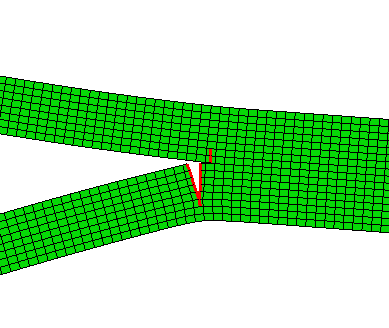
Products: Abaqus/Standard Abaqus/CAE
Benefits: The extended finite element method (XFEM) allows you to model discontinuities, such as cracks, along an arbitrary, solution-dependent path. The mesh is not required to conform to the discontinued geometry when you study crack growth with XFEM; therefore, you do not need to remesh the bulk materials to account for the presence of the crack.
Description: When you model a crack with the conventional finite element method, the mesh must always conform to the discontinued geometry. Modeling a crack that is growing is even more cumbersome because you must continually update the mesh to match the geometry of the discontinuity as the crack progresses and new edges appear. In contrast, XFEM allows you to model crack growth without remeshing the crack surfaces. Special displacement functions, in conjunction with additional degrees of freedom of elements in the crack domain, ensure the presence of discontinuities.
You can use Abaqus/CAE to specify the crack domain and allow Abaqus to determine how the crack is initiated and how the crack propagates along an arbitrary, solution-dependent path through the region. Crack propagation is illustrated in Figure 6–1 for a three-dimensional solid block subjected to pure mode II loading. XFEM can also be simultaneously used with the surface-based cohesive behavior approach or the Virtual Crack Closure Technique, both of which are best suited for modeling interfacial delamination.
An example of interfacial delamination is illustrated in Figure 6–2. In this figure, interfacial delamination simulated with a surface-based cohesive approach is arrested due to the presence of the through-thickness cracks simulated with XFEM.
XFEM is available only for first-order three-dimensional solid parts, two-dimensional planar models, and orphan meshes. You can use the view cut manager and time history animations in the Visualization module of Abaqus/CAE to view the onset and growth of an XFEM crack.
Crack growth plays a short video that shows the crack growth in the same three-dimensional block subjected to pure mode II loading.
Figure 6–2 Interfacial delamination with the surface-based cohesive approach in conjunction with crack propagation through the thickness simultaneously simulated with XFEM.

Interaction module: SpecialCrack
Create
XFEM